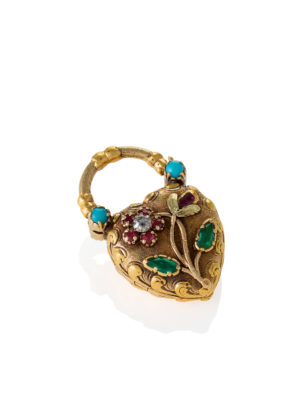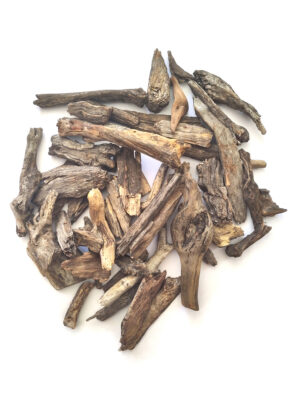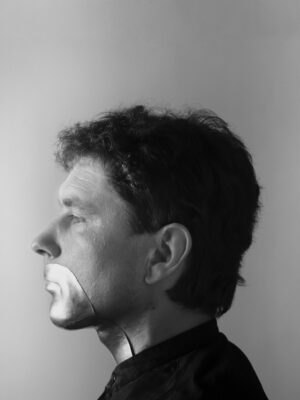Macklowe’s collection begins in the early Victorian Era, named, of course, for Queen Victoria, reigning Queen of England from 1837 to 1900. It is important to note that Queen Victoria was coronated in the same year that the daguerreotype was invented, meaning that her reign was the first to be widely photographed. She was among the very first to have images capturing her style and, naturally, her jewelry, widely dispersed to the international public. Although she was coronated in 1837, her style was most widely celebrated on the occasion of her wedding to her first cousin, the German Prince Albert, in 1840. The great love affair that blossomed between the young Queen and her Prince Consort inspired a sentimentality in jewelry heretofore unseen.
Lockets, pendants, bracelets, and rings meant to contain locks of a beloved’s hair became widely popular. The same can be said of acrostic jewelry — jewelry in which the first letter of each center stone spells out a love message. Although acrostic jewelry was originally made fashionable by Marie Antoinette and the French firm Mellerio, Prince Albert revived the practice by commissioning acrostic jewels for Queen Victoria and their daughters. Early Victorian jewelry is charged with symbolism. Entwined snakes, symbols of eternal devotion, became popular on arm bands and wedding rings. Pieces in blue enamel and turquoise were prized because of their association with the color of the forget-me-not, which, in the Victorian language of flowers, was the ultimate symbol of enduring romantic love.
COMMON NAME Early Victorian
SCIENTIFIC NAME High-Key Romantic Jewelry
DATE 1837-1861
FORM Acrostic jewelry, lockets, pendants, armbands, and five-gemstone rings
FEATURES Secret compartments, hearts, and devotional snakes
SIZE Substantial and layered
WEIGHT Light and airy
VIBE Lovestruck, sappy, and sentimental
DIET Chocolate hearts and love potions (exclusively)
AVERAGE LIFE SPAN IN THE WILD 25 years
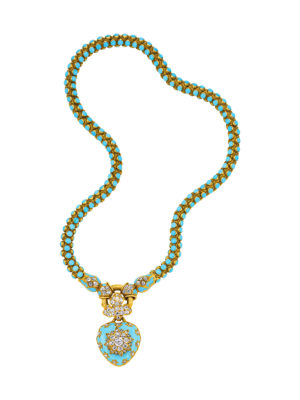
The “Mid” or “High” Victorian Era, which began in 1860, maintains the hallmarks of the Victorian style with two very notable changes. The first was due to the fact that, in the 1860s, diamonds were discovered in South Africa. Large scale, highly exploitative diamond mining operations were established there, and the new abundance of gemstones that followed meant that large, predominantly diamond jewelry became not only plausible, but fashionable in England.
The other great change that occurred during this period was the death of the Prince Consort Albert in 1861. After losing her great love, Queen Victoria had the British royal court present themselves exclusively in what was considered “mourning jewelry“ for nearly a decade, creating a huge market and massive interest in jewelry in somber colors featuring garnets, topaz, jet, gutta percha, etc., and including hair of the departed or miniature portraits meant to encourage remembrance. Concurrently, this period of empire and burgeoning international trade also witnessed the excavation of Pompeii, the opening of European trade with Japan, and the construction of the Suez Canal by the British. The jewelry of the moment reflected these events, with Etruscan Revival being championed by the house of Castellani, and both Japanese- and Egyptian-inspired jewelry being made across Western Europe.
COMMON NAME High Victorian
SCIENTIFIC NAME Mourning Jewelry, Sad Boi Jewelry (RIP Prince Consort Albert)
DATE 1861-1900
FORM Lockets, hair jewelry, and poison rings
FEATURES Black and other dark colors, hair, miniature portraits, topaz, jet, gutta-percha, and MEGA diamonds (due to the brutal exploitation of South Africa)
SIZE Delicate detail on a large scale
WEIGHT Physically light, emotionally heavy
VIBE Sad, sentimental, weepy, repressed, oh-so-slightly creepy, yet très glittery
DIET Industrial smoke and bottled tears
AVERAGE LIFE SPAN IN THE WILD 40 years of national mourning (yikes)
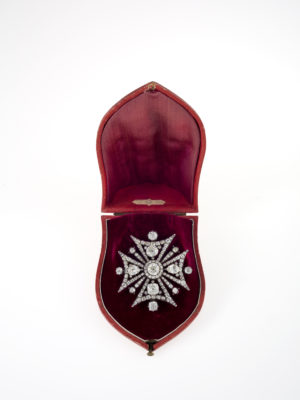
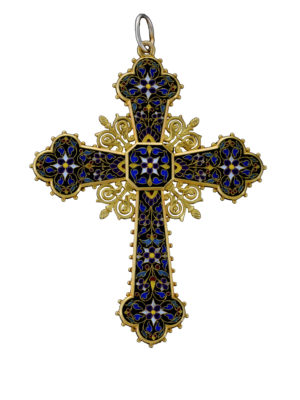
The Victorian Era saw the introduction of technical innovations at a rate that had eluded previous generations. This rapid introduction of mass manufactured goods created an interest, among the likes of William Morris and Arthur Liberty, in returning to decorative arts that were made according to meaningful designs and produced by trained artisans. This resulted in the Arts & Crafts movement.
Following closely on the heels of the English Arts & Crafts movement was an international style that also celebrated highly detailed and hand-crafted decorative arts, that sought to integrate and elevate the decorative arts in everyday life, and that was deeply influenced by Japanese art forms: Art Nouveau. Art Nouveau (Jugendstil in German, Stile Liberty in Italian, and Modernisme in Catalan) was a short-lived movement that lasted from the mid-1890s to about 1910. Art Nouveau sought to imitate the beautiful imperfections of nature on a poetic scale and found champions and female models in the likes of famous dancers and performers such as Sarah Bernhardt and Löie Fuller. Art Nouveau jewelry favored laborious hand-executed techniques, like enameling, and tended to include full compositions, often featuring a feminine form. It served as a rejection of and aesthetic counterpoint to the mere arrangement of gems or bands of metal seen in Victorian jewelry.
COMMON NAME: Art Nouveau
SCIENTIFIC NAME: Flower Power Jewelry
DATE: 1900
FORM: Pendants, rings, bracelets, and hair combs, but NEVER earrings
FEATURES: Sinuous lines, ultra-feminine, ultra-floral, funky gemstones, detailed enamel work, vignettes of female figures, natural forms, and a Japanese-inspired
linear style that sometimes veered into problematic Orientalism
SIZE: Exactly as big as it needs to be, man
WEIGHT: Ethereally light
VIBE: Au naturale
DIET: A raw keto diet of edible flowers
AVERAGE LIFE SPAN IN THE WILD: 5-8 years
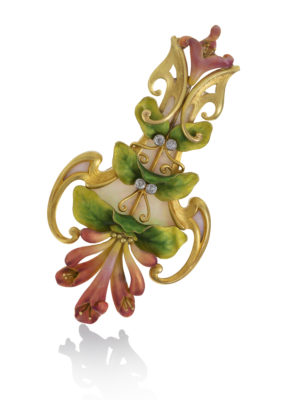
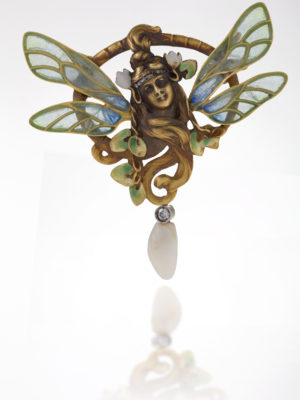
In 1901, England coronated a new monarch, King Edward VII, and he ushered in a distinct style of jeweled ornament that would long outlive him. After the intensely somber aesthetic of the late Victorian Era, Western Europeans were excited by the style of the lavish and fancy-free new King, and so the “Belle Epoque” was ushered in. Many were quick to compare Edward’s court to the opulence and decorative joy of the courts of Versailles, and jewelry wearers of the day were eager for the return of the lightness, elegance, lavishness, and joyfulness of the old French style.
There was one key technical innovation, accomplished in 1900, that was to allow for the execution of this delicate yet extravagant style: the invention of the oxyacetylene torch, which made possible the commercial use of platinum for the
first time since the metal’s discovery. Platinum, which is lighter and stronger than gold, and unlike silver does not tarnish, became the premier choice for the elaborate, lacelike diamond- and pearl-studded jewelry — fashioned in delicate bows, garlands, and ribbon-like forms — that adorned the lightly hued, highly embroidered velvet and satin womenswear of the day.
COMMON NAME: Edwardian
SCIENTIFIC NAME: Downton Abbey Jewelry, Belle Époque
DATE: 1900-1920s
FORM: Pearl strands, long sautoirs, tiaras, bracelets, rings, and brooches
FEATURES: Garlands, bows, diamonds, seed pearls (1905: first spherical cultured pearl created by Kokichi Mikimoto), and always P.L.A.T.I.N.U.M (1900: platinum is used commercially after the invention of the super-hot oxyacetylene torch)
SIZE: Chic and petite
WEIGHT: Ultralight (platinum and pearls practically float)
VIBE: Posh, yet fun-loving
DIET: Champagne and caviar
AVERAGE LIFE SPAN IN THE WILD: 20 years
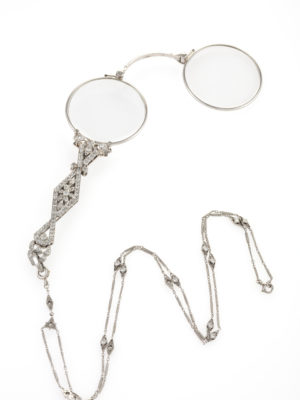
The Edwardian style remained predominant until the disruption of WWI decimated Europe’s demand for luxury items and limited access to the precious materials needed to make jewelry. After the war, women, who had had entered the workforce in droves, were reluctant to return to constraining corsets and cumbersome long skirts, and so women’s fashion was changed by the likes of Paul Poiret and Coco Chanel with the introduction of shorter hemlines and streamlined silhouettes. In combination with the artistic revolution that was Cubism, these developments created a great demand for jewelry with stark, clean architectural lines that celebrated the new wealth and prosperity of the 1920s. The result was the movement that was dubbed “Art Deco” after the Exposition Universelle in Paris in 1925.
COMMON NAME: Art Deco
SCIENTIFIC NAME: Jay Gatsby & Co. Jewelry
DATE: 1925-1937
FORM: Large bracelets, architectural brooches, and decadent drop earrings
FEATURES: Stark, rectilinear, intricate, geometric lines (à la Braque & Picasso), cubism, carved and colored accent gemstones, all white everything (1917: invention of white gold), diamonds, diamonds, and more diamonds
SIZE: Over the top, old sport
WEIGHT: Heavy (and I do mean carat weight)
VIBE: You have seen Baz Luhrmann’s The Great Gatsby, right?
DIET: Endless hors d’oeuvres and scotch on the rocks
AVERAGE LIFE SPAN INTHE WILD: 5-10 years
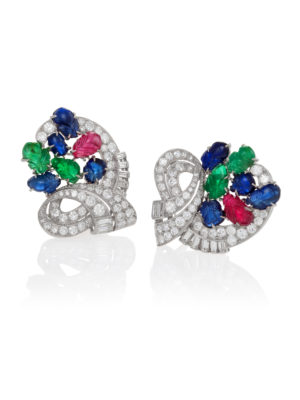
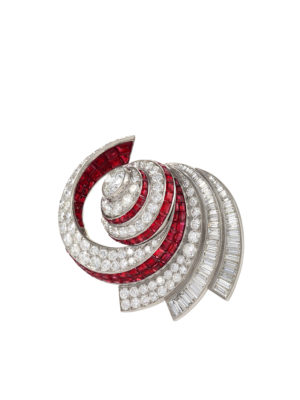
Art Deco’s stark but gemmy extravagance would survive the stock market crash of 1929 and would in fact grow only more and more opulent through the early 30s. By the 1937 International Exposition of Arts and Technology in Modern Life in Paris, a new style had emerged, and it marked a glaring shift from the white metal, white diamonds and strictly geometric designs of Deco. The jewelry exhibited was largely in polished gold, mirrored natural forms in dramatic scrolls and volutes and floral shapes, and incorporated colored gemstones. Some 40 years later, this style would be dubbed “Retro”. Retro remained a super luxe and over-the-top trend until the beginning of World War II.
After the outbreak of WWII, gold became scarce, and so different alloys of gold, including rose gold, became more popular, as did lower karat gold. The ”tank“ bracelet, mirroring the appearance of tank tracks, became hugely popular, as did hollow tubogas and snake chains, which also mirrored the appearance of wartime industrial equipment. Highly textured metal or pave-set small stones made up for the lack of large gemstones, and semi-precious stones like amethyst, topaz, and aquamarine rose to prominence. Patriotic jewelry such as Van Cleef and Arpel’s Hawaii collection and Mauboussin’s Jeep brooch also became popular and remain very collectible to this day.
Women of the 1950s, who once again suddenly had access to gold, platinum, and major gemstones, enjoyed the prosperity that followed the misery of war. Ladies’ fashion returned to hyper-feminine forms, inspiring flamboyance in jewelry design. The “Retro” look largely maintained, but movements like Surrealism and Abstract Expressionism challenged jewelers to add more textures and more dynamism to their designs. Intricate texture, asymmetry, and delicate color palettes became the norm, reflecting the artistic trends of the day, while a sense of whimsy, particularly found in the animal pins created by many American and French firms, demonstrated the joy felt by the parts of the world no longer ravaged by war.
COMMON NAME: Retro
SCIENTIFIC NAME: Rosie the Riveter Jewelry
DATE: 1937-1950
FORM: Tank bracelets, chunkalicious rings, and earrings finished off with tassel necklaces
FEATURES: Everything and we do mean everything in bright, polished gold (WWII: platinum was named a strategic metal in Europe and the US and thus could not be used recklessly)
SIZE: As big as those guns, girl
WEIGHT: Industrial strength
VIBE: Chunky, industrial jewelry for women rocking the war effort on the home front
DIET: Nails for breakfast, and that’s it
AVERAGE LIFE SPAN IN THE WILD: 12-15 years
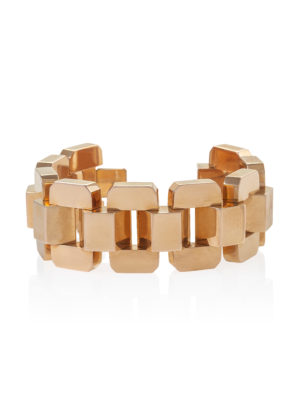
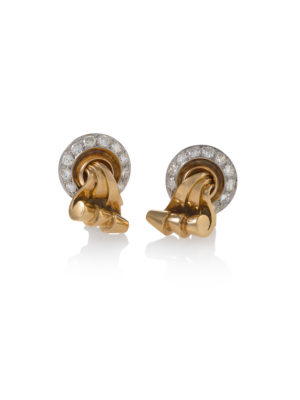
Jewelry’s innovations and trends are dictated, more than any other medium, by the material advances and technical innovations available in any day and age. We at Macklowe Gallery believe that to understand and love jewelry is to understand and love history, and that to collect jewelry is to invite beauty of historical importance into your life. Invite some beauty into your love life:
DATE JEWELRY
This article is published in the 2019 New York City Jewelry Week Paper, the result of a collaboration between Current Obsession and NYCJW.
